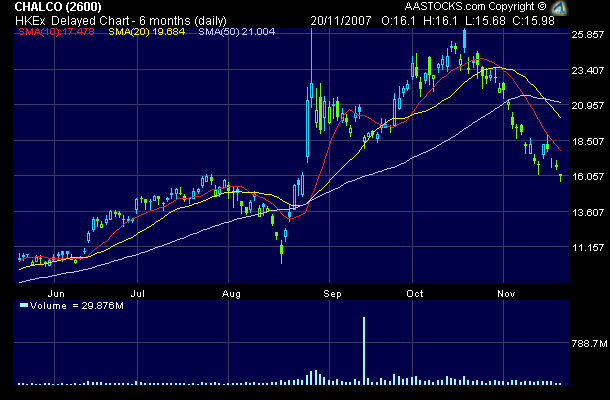China's Loss Is Alcoa's Gain as Aluminum Curbs Boost Producers
Aluminum producers, the laggards of the mining boom, may rise as China reduces sales onto the world market and buys more of the metal from overseas.
China's net aluminum exports have fallen this year as the government cut tax incentives for overseas sales and curbed smelter expansion to save energy and ease pollution. The nation, the world's largest consumer of aluminum, may become a net importer of the metal next year for the first time since 2001, according to UBS AG.
Average prices on the London Metal Exchange will rise 30 percent by 2009, Sanford C. Bernstein said on Oct. 19. Morgan Stanley and UBS also forecast higher prices. That will boost the shares of the world's biggest producers: Alcoa Inc., Rio Tinto Group and Norsk Hydro ASA, UBS said. The top five, also including Aluminum Corp. of China Ltd., or Chalco, and Moscow-based United Co. Rusal, account for 38 percent of global output, according to HSBC Holdings Plc.
``The outlook for the aluminum industry is favorable because of worldwide demand,'' led by China, said Peter Klein, who helps oversee $21 billion at Fifth Third Asset Management. ``Companies like Alcoa stand to benefit from that and M&A activity in the sector as resource companies look to diversify. That story isn't finished yet.''
Cleveland-based Klein is considering buying more shares of New York-based Alcoa, he said.
Rio, the world's third-largest mining company, paid $38.1 billion this year for Alcan Inc., beating Alcoa to become the top aluminum producer. London-based Rio is forecasting global demand to gain more than 6 percent annually to 2011.
`Good for Pricing'
Since then, BHP Billiton Ltd., the world's biggest mining company, has made a stock offer for Rio in what would be the world's largest takeover. Rusal, the second-largest aluminum producer, was created this year through the merger of OAO Russian Aluminium, OAO Sual Group and the alumina unit of Glencore International AG.
``We're seeing a consolidation theme sweep through the aluminum sector and that's going to be good for pricing,'' said Adam Dixon, who helps manage about $11.6 billion at Ausbil Dexia in Sydney, including Rio stock. ``Rio Tinto has potentially put its foot on the lowest cost production globally.''
Alcoa has gained 21 percent this year and is trading at 13 times estimated earnings. Oslo-based Hydro, Europe's second- largest aluminum producer, is trading at 10 times earnings and has jumped 20 percent this year. The Bloomberg World Mining Index is trading at 18 times earnings and has risen 72 percent.
Supply
Aluminum for immediate delivery closed at A$2,502.1 a ton on Nov. 16. It will average $3,266 a ton in 2009 according to Sanford C. Bernstein's Andrew Keen. The metal may reach a record $4,000 a metric ton as early as next year, Alexander Bulygin, chief executive officer of Rusal, said in March.
Expanding supplies may prove him wrong. Global inventories of aluminum on the LME have jumped 50 percent in the past two years. Aluminum cash prices may average 13 percent lower next year as rising inventories put pressure on prices, JPMorgan Securities Ltd. forecast last month.
``Aluminum stocks on the LME are very high,'' said Troy Angus, who helps manage $3.5 billion at Paradice Investment Management Ltd. in Sydney. ``An expectation that the Chinese will stop exporting the metal is I think a dangerous assumption to make.''
Still, producers of aluminum are predicting rising demand. China's usage will jump 30 percent this year and gain 15 percent a year until 2011, Rio Chief Executive Tom Albanese said in September. Rusal forecast in August that global demand will more than double by 2030.
`Excess Power'
China's drive to cut power consumption and reduce aluminum overcapacity may slow growth enough that the nation becomes a net importer of the metal in the fourth quarter of 2008, said Chris Ding, a Beijing-based analyst at China International Capital Corp., the nation's biggest investment bank.
The country's net aluminum exports dropped this year after the government raised export taxes in 2006 to 15 percent from 5 percent. The government also removed a tax rebate on exports of some aluminum products to curb smelter expansion. Energy accounts for about 40 percent of the metal's production cost, according to Citigroup Inc.
``Aluminum is a significant consumer of power and clearly five years ago China was an area with excess power,'' said Tim Barker, who helps manage and advise on $54 billion of assets at BT Financial Group in Sydney, including Rio. ``That excess power production has disappeared.''
The price of aluminum has lagged behind the four-to-fivefold gains of nickel and copper in the past five years, adding 81 percent.
Aluminum is smelted from alumina, a secondary material that is refined from bauxite ore.
Chalco Soars
Chinese aluminum producers such as Chalco, the country's largest producer, have benefited from restrictions placed on smaller domestic producers. The company is driving acquisitions in the industry by buying rival smelters and bauxite mines. Its shares have more than doubled on Hong Kong's benchmark Hang Seng Index this year, compared with the index's 37 percent gain.
``There's no question this is the possible opportunity for aluminum that everybody has been looking for throughout the cycle,'' said Peter Richardson, a Melbourne-based strategist at Craton Capital Ltd., which has $350 million under management. He recommends shares of ``lower-power cost companies such as Rio.''
Chalco HK -3,7% = 15,98h$
|
Angehängte Grafik:
charts.gif (verkleinert auf 83%)


 |
2
|
2

 Thread abonnieren
Thread abonnieren


